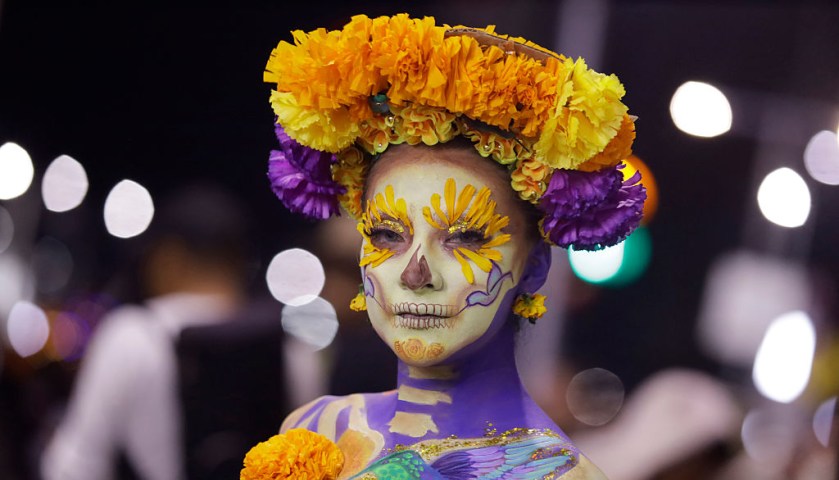Russell Simmons Explains His Stance on Diamonds & DeBeers
Russell Simmons Explains His Stance on Blood Diamonds, DeBeers and African Development - Page 2
Share the post
Share this link via
Or copy link
by R. Asmerom
Russell Simmons obviously needs no introduction. His numerous successes as a business and media mogul are rivaled only by a few others in the world. Despite all his successes, however, Simmons is not immune from the criticism of his politics. We recently questioned Simmons’ stance on the diamond industry in light of Naomi Campbell’s current entanglement with the war crimes trial of former Liberian President Chuck Taylor. In 2006, Simmons’ take on the diamond industry was highlighted when the film Blood Diamonds opened. Instead of explaining the situation further, we decided to have Simmons and Dr. Benjamin Chavis, Governing Board Co-President of Simmons’ Diamond Empowerment Fund, address the issue of Blood Diamonds and the work of their Diamond Empowerment Fund. Here’s what the two had to say:
On Simmon’s relationship with the diamond business…
I am not in and have never been in the diamond mining business, I am in the jewelry business. My involvement in the diamond business is to help bring greater support around education initiatives for Africans and is a non-profit, philanthropic initiative. I do not profit from my efforts around education for Africans. I do not make money from Africa. I make money for Africa.
On how Simmons formulated his opinions on the relationship between diamonds and African development…
Our stance on the diamond industry’s participation in the development and empowerment of people in Africa where diamonds are a natural resource was developed after direct consultation from African leaders such as Nelson Mandela and others who are indigenous to major diamond producing African nations. Prior to establishing the Diamond Empowerment Fund, we traveled to Africa specifically on a fact-finding mission to witness first hand what was happening with the diamond industry in South Africa and Botswana. We also traveled to Mozambique to have a private meeting with former South African President Mandela.
We also met with leading Africa businessmen such as Patrice Motsepe and we met with then President Festus Mogae of Botswana and other regional and local officials in South Africa and Botswana. We also reviewed Business Leadership South Africa’s “The Stuff of Legends: Diamonds and Development in Southern Africa” study published in November 2006. BLSA is an association of South Africa’s largest corporations and major multinational companies with a significant presence in South Africa. The study independently determined that the diamond industry has been a positive force in the economic development of Southern Africa.
Further, we visited schools both in Botswana and South Africa, such as CIDA City Campus in Johannesburg. We spoke with workers, family members, and visited schools and hospitals in mining communities. We also met with tribal leaders in both Botswana and South Africa who expressed their support of the diamond industry’s contributions to the ongoing development of their communities. We assessed first-hand our observations of how these communities were being positively impacted and the quality of life in these communities was being directly improved as beneficiaries of revenue generated through the diamond industry. We also met with miners, as well as native Africans who were working throughout the chain of the diamond pipeline, specifically those employed in the sorting, cutting, polishing, and valuation of diamonds. These are all highly-skilled workers, and seeing all of these people at work was in direct contradiction to what we were told – that no black Africans were employed in the diamond industry in Africa.
One of the key questions of our fact-finding mission was to determine the extent to which the diamond industry was being accountable to these communities. Of the various industries that extract minerals, and other natural resources from Africa, we were encouraged by how the diamond industry works with communities at the local, regional and national level to adhere to standards of engagement that have led to the empowerment of people and communities where diamonds are a natural resource.
Not withstanding our documenting the current level of support that the diamond industry contributes to Africa, we wanted to build on the foundation that had been laid to engage the international diamond jewelry industry in greater support for Africa, particularly around access to education. The mining that occurs in Africa is just one component of the international diamond and jewelry sector. We wanted to sensitize the entire industry to the needs of the people in the communities in which many of their materials are extracted with the intention that they would get involved to help the cause. Simply stated, the Diamond Empowerment Fund exists to raise awareness and support for greater empowerment through education for indigenous people in diamond producing nations, especially the youth.
On his relationship with DeBeers, the largest diamond company in the world…
My relationship with DeBeers is not business. Simmons Jewelry Company is not a diamond company, it is a jewelry company. When I got into the jewelry business, I wanted to find a way to be helpful and bring a cause element to Simmons Jewelry Co. Africa was a natural fit given the tremendous need for greater support for Africa and the fact that many of the materials used in jewelry, including diamonds, are extracted from Africa. As a result of being in the business, we met the people from DeBeers and established a relationship through the founding of the Diamond Empowerment Fund that is purely philanthropic.
DeBeers’ support of the establishment of the Diamond Empowerment Fund did not happen as a result of our position on the Blood Diamond movie. In fact, we did not issue criticism of the Blood Diamond movie as a result of financial support from DeBeers. The establishment of the Simmons Jewelry Co predated the Blood Diamond movie. Our relationship with DeBeers came as a direct result of the Simmons Jewelry Co being in the industry. Simmons Jewelry Co. is a small company and through our company we have given at least 10 times as much as I have earned to support access to education in Africa.
Prior to the film’s release, there was a lot of misinformation we were receiving in our research on the issues from many sources. We challenged DeBeers to show us their operations in South Africa and Botswana firsthand and they readily accepted. The awful tragedy that happened in Sierra Leone that was depicted in the Blood Diamond movie was not the reality in South Africa or Botswana, which incidentally is the largest diamond-producing nation in the world.
There needs to be a distinction made between alluvial diamond mining and formal diamond mining. Formal diamond mining, prevalent in Southern Africa is able to be ring-fenced with proper procedures and safety measures put in place. Alluvial diamond mining (diamonds found in river beds, ocean floors, shore lines, etc) is prevalent in Western Africa and is impossible to ring-fence given that most alluvial diamond deposits are spread across huge geographic areas which cannot be easily isolated or monitored. These deposits tend to be mined by individuals, families or groups – commonly referred to as diggers. There are a number of issues concerning the working conditions of this type of mining including the unhealthy, unregulated and sometimes dangerous environments in which the diggers work, together with the fact that the majority of diggers do not know the true value of rough diamonds and are therefore vulnerable to exploitation. This type of mining was exploited and as a result there was social and economic unrest Sierra Leone, which then financed the country’s brutal war in the late 1990’s – and is also, of course, the backdrop for the Blood Diamond movie.
Critics of the diamond industry very commonly misunderstand the distinction between these two forms of mining. They also don’t realize that in many cases the alluvial diamond mining workers have no other option for employment and support a whole family on the substance wage given (even if it is $1 a day). The situation alluvial miners face today reflect the fundamental challenges of extreme poverty and a lack of basic infrastructure, education and healthcare in previously war-torn countries. Also unknown to these critics are efforts such as The Diamond Development Initiative, announced at the 2006 Clinton Global Initiative and founded by partnerships between the diamond industry members, NGOs and governments. The DDI aims to find sustainable methods of ensuring that diamonds are mined and distributed for the benefit of local communities and local governments. To learn more about their important work on behalf of more than a million artisanal diamond diggers and their families who are struggling for survival in countries that have been ravaged by war, go to http://www.ddiglobal.org.
Compared to most countries on the continent, African countries with formal diamond mining do well in terms of human development; if you take a look at the HDI map (Human Development Index which measures long-term well-being and quality of life through factors such as life expectancy, education and income), you’ll see that compared to most other African countries, those countries with formal diamond mining do well in terms of human development. In fact, South Africa, Botswana and Namibia are all in the top six among countries covered in the map.
The diamond industry decided to establish the Kimberley Process to prevent conflict diamonds from being sold on the international markets. The phenomena of conflict diamonds in Sierra Leone as portrayed in the Blood Diamond film was one of the reasons why the Kimberley Process was established. In 2000, producer nations and the global diamond industry made clear to the international community its zero tolerance policy towards conflict diamonds. Dedicated to eradicating the trade in conflict diamonds, these countries and the global diamond industry worked closely with the United Nations, NGO’s such as Global Witness and Partnership Africa Canada to create the Kimberley Process Certification System. This system was formally adopted in 2003 and guards against conflict diamonds entering the legitimate diamond supply chain. The diamond industry also adopted a voluntary System of Warranties to assure consumers that their diamonds are from sources free of conflict. 74 governments have enshrined into their national law the Kimberley Process Certification System, and now more than 99% of the world’s diamonds are from conflict free sources. The diamond industry continues to work with governments, NGOs and the UN to strengthen the Kimberley Process and the System of Warranties. Today, more than 99% of the world’s diamonds are now from conflict free sources and are officially traded under the UN mandated Kimberley Process. There’s more information available at diamondfacts.org.
On the backlash from his critique on the Blood Diamonds film….
Our position is that there should be no conflict diamonds. We did not initially critique the film and therefore if there was any backlash, it was as a result of misunderstanding and misinformation of our position.
On Naomi Campbell’s alleged involvement with Chuck Taylor…
Naomi Campbell is a strong supporter of human rights, not only in Africa but also for people throughout the world. We do not have any information about allegations concerning Naomi Campbell.
On Diamond Empowerment Fund’s current projects…
In keeping with the Diamond Empowerment Fund’s mission of supporting education initiatives that develop and empower those most disadvantaged in African nations where diamonds are a natural resource, the organization looks to fund projects that have proven success in providing African youth with high-quality educational experiences, including skill-building and vocational training initiatives. A philosophical and pragmatic commitment to self-determination is important to D.E.F. as it takes a partnership approach in selecting organizations that will be recipients of funding. D.E.F looks for efforts where there is a proven history of educational excellence, sound administrative management, and a clearly articulated financial need.
To further the goal of having a significant and measurable impact on beneficiary organizations, D.E.F. has two beneficiaries, CIDA City Campus and African Leadership Academy, both based in Johannesburg, South Africa.













